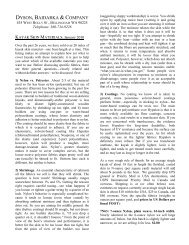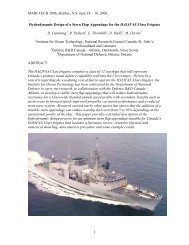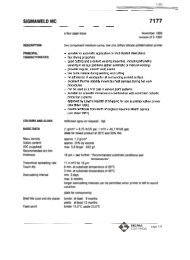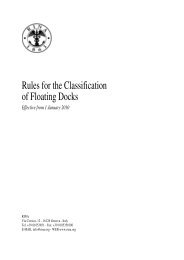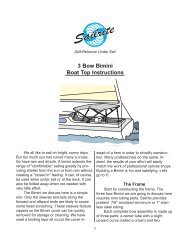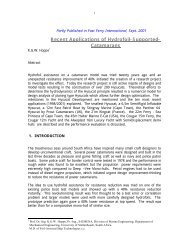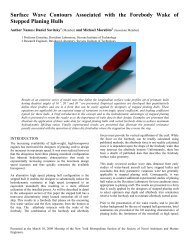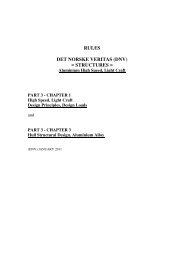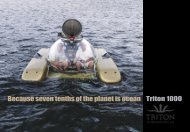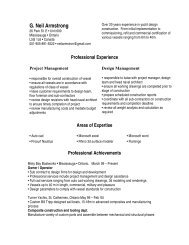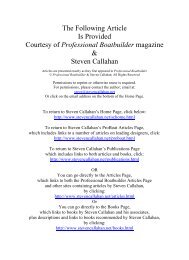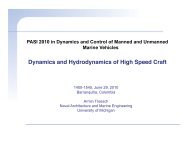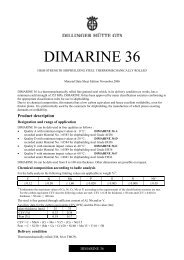SECTION 1 - Boat Design Net
SECTION 1 - Boat Design Net
SECTION 1 - Boat Design Net
Create successful ePaper yourself
Turn your PDF publications into a flip-book with our unique Google optimized e-Paper software.
Pt B, Ch 3, Sec 2where:F : Wind force, in NC s : Shape coefficient. Without specific availabledata, this coefficient has to be taken equal to1,1ρ : Air mass density, equal to 1,222 kg/m 3A : Projected area of all the exposed surfaces, insquare metresV : Maximum wind speed, in m/s, for which theyacht is able to operate for each specific combinationof sails as described in [3.3.2].3.3.4 The wind moment is the force F as calculated in[3.3.3], multiplied by the heeling lever Z. The heeling leverZ is the vertical distance in m, from the centre of A to thecentre of the underwater lateral area or approximately to apoint at one half the draught.The wind heeling lever is calculated as follows:λ = λ(0) (cosθ) 2where λ(0) is the wind heeling lever at 0°.3.3.5 CriteriaUnder the assumptions of [3.3.4], the following criteria areto be complied with:• the metacentric height corrected by the free surfaceeffects, has to be greater or equal to 0,30 m• the angle of the static heel due to the effect of wind hasto be limited to 20° or 90% of the immersion of thedeck, whichever is less• the rigthing lever GZ is to be at least 0,50 m at an angleof heel equal to or greater than 50°• the area above the wind heeling lever λ and below theGZ curve, between the angle of static wind heel and thedownflooding angle, has to be at least equal to0.065 mrd.4 Effects of free surfaces of liquids intanks4.1 General4.1.1 For all loading conditions, the initial metacentricheight and the righting lever curve are to be corrected forthe effect of free surfaces of liquids in tanks.4.2 Consideration of free surface effects4.2.1 Free surface effects are to be considered wheneverthe filling level in a tank is equal or less than 98% of fullcondition. Free surface effects need not be consideredwhere a tank is nominally full, i.e. filling level is above98%. Nevertheless, in order to take into account the consumptionof consumable just after departure, the requirementof [4.2.2] has to be considered.4.2.2 In calculating the free surfaces effect in tanks containingconsumable liquids, it is to be assumed that for eachtype of liquid at least one transverse pair or a single centrelinetank has a free surface and the tank or combinationof tanks taken into account are to be those where the effectof free surface is the greatest.4.3 Water ballast tanks4.3.1 Where water ballast tanks are to be filled or dischargedduring the course of a voyage, the free surfaceseffect is to be calculated to take account of the most oneroustransitory stage relating to such operations.4.4 GM 0 and GZ curve corrections4.4.1 The corrections to the initial metacentric height andto the righting lever curve are to be addressed separately asindicated in [4.7.2] and [4.7.3].4.4.2 In determining the correction to the initial metacentricheight, the transverse moments of inertia of the tanksare to be calculated at 0 degrees angle of heel.4.4.3 The righting lever curve may be corrected byany of the following methods:• correction based on the actual moment of fluid transferfor each angle of heel calculated• correction based on the moment of inertia, calculated at0 degrees angle of heel, modified at each angle of heelcalculated.4.4.4 Whichever method is selected for correcting therighting lever curve, only that method is to be presented inthe yacht’s trim and stability booklet. However, where analternative method is described for use in manually calculatedloading conditions, an explanation of the differenceswhich may be found in the results, as well as an examplecorrection for each alternative, are to be included.4.5 Remainder of liquid4.5.1 The usual remainder of liquids in the empty tanksneed not be taken into account in calculating the corrections,providing the total of such residual liquids does notconstitute a significant free surface effect.5 Icing5.1 Application5.1.1 For any yacht operating in areas where ice accretionis likely to occur, adversely affecting a yacht's stability,attention is to be paid to the effect of the ice. The Societyreserves its right to request additional calculations on a caseby case basis.92 Bureau Veritas Rules for Yachts July 2006 with February 2008 Amendments



